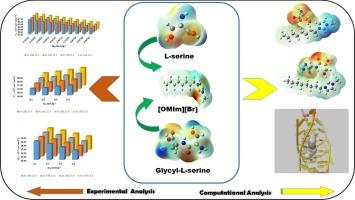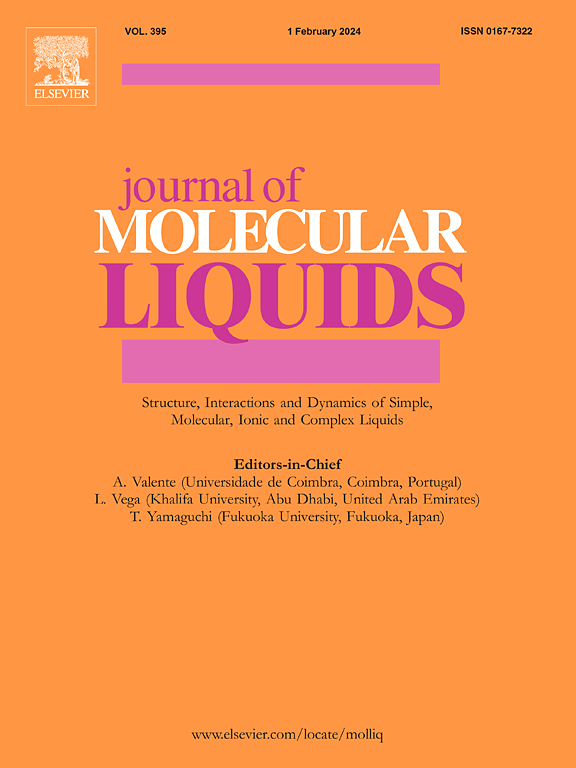表面活性离子液体 (SAIL) 与某些生物大分子分子相互作用的新见解:实验和计算方法
IF 5.2
2区 化学
Q2 CHEMISTRY, PHYSICAL
引用次数: 0
摘要
了解离子液体(IL)对水溶液中生物分子溶解度的影响对于设计和优化新型生物技术过程至关重要。然而,这种影响的分子水平机制仍无定论,也未完全阐明。为了帮助理解氨基酸和离子液体在水介质中的分子相互作用,我们在 T = (288.15, 298.15, 309.15, 309.15) 温度下测量了 L-丝氨酸和甘氨酰-L-丝氨酸在 (0.00, 0.005, 0.01, 0.03, 0.05) mol-kg-1 的 1-辛基-3-甲基溴化咪唑水溶液中的密度和声速。根据实验数据研究了各种热力学参数,如表观摩尔体积 (Vϕ)、部分摩尔体积 (Vϕ0)、标准部分摩尔转移体积 (ΔVϕ0)、部分摩尔等熵压缩 (Kϕ,s) 和部分摩尔等熵压缩转移 (ΔKϕ,S0)。除实验结果外,还利用计算工具对分子变化进行了深入了解。通过密度泛函理论(DFT),计算并利用最高占有分子轨道(HOMO)和最低未占有分子轨道(LUMO)获得了分子描述符,如电离能(I)、电子亲和力(A)、硬度(η)、软度(S)、化学势(μ)和电负性(χ)。预测了热化学性质,包括热焓(ΔH)和吉布斯自由能(ΔG)的变化。分子对接研究用于分析离子液体与 I-Motif 结构的分子相互作用及结构变化。本文章由计算机程序翻译,如有差异,请以英文原文为准。

New insight into molecular interactions of surface-active ionic liquid (SAIL) with some biomolecules: Experimental and computational approaches
Understanding the influence of ionic liquids (ILs) on the solubility of biomolecules in aqueous solutions is crucial for designing and optimizing novel biotechnological processes. However, the molecular-level mechanisms underlying this influence remain inconclusive and not fully elucidated. To contribute toward the understanding of molecular interactions between amino acids and ionic liquid in aqueous media, measurements of the densities and speeds of sound for L-serine and glycyl-L-serine in (0.00, 0.005, 0.01, 0.03, and 0.05) mol·kg−1 aqueous solutions of 1-octyl-3-methylimidazolium bromide were conducted at T = (288.15, 298.15, 308.15, and 318.15) K. From experimental data various thermodynamics paramours such as apparent molar volume (Vϕ), the partial molar volume (), standard partial molar volumes of transfer () partial molar isentropic compression (Kϕ,s) and partial molar isentropic compression of transfer () have been examined. Along with experiment results, computational tools were also utilized for a deeper understanding of the molecular changes. From density functional theory (DFT), the highest occupied molecular orbital (HOMO) and lowest unoccupied molecular orbital (LUMO) were calculated and utilized to obtain molecular descriptors such as ionization energy (I), electron affinity (A), hardness (η), softness (S), chemical potential (μ), and electronegativity (χ). Thermochemical properties, including change in enthalpy (ΔH), and change in Gibbs free energy (ΔG), were predicted. Molecular docking studies were used to analysis the molecular interaction of ionic liquid with I-Motif structure and structural changes.
求助全文
通过发布文献求助,成功后即可免费获取论文全文。
去求助
来源期刊

Journal of Molecular Liquids
化学-物理:原子、分子和化学物理
CiteScore
10.30
自引率
16.70%
发文量
2597
审稿时长
78 days
期刊介绍:
The journal includes papers in the following areas:
– Simple organic liquids and mixtures
– Ionic liquids
– Surfactant solutions (including micelles and vesicles) and liquid interfaces
– Colloidal solutions and nanoparticles
– Thermotropic and lyotropic liquid crystals
– Ferrofluids
– Water, aqueous solutions and other hydrogen-bonded liquids
– Lubricants, polymer solutions and melts
– Molten metals and salts
– Phase transitions and critical phenomena in liquids and confined fluids
– Self assembly in complex liquids.– Biomolecules in solution
The emphasis is on the molecular (or microscopic) understanding of particular liquids or liquid systems, especially concerning structure, dynamics and intermolecular forces. The experimental techniques used may include:
– Conventional spectroscopy (mid-IR and far-IR, Raman, NMR, etc.)
– Non-linear optics and time resolved spectroscopy (psec, fsec, asec, ISRS, etc.)
– Light scattering (Rayleigh, Brillouin, PCS, etc.)
– Dielectric relaxation
– X-ray and neutron scattering and diffraction.
Experimental studies, computer simulations (MD or MC) and analytical theory will be considered for publication; papers just reporting experimental results that do not contribute to the understanding of the fundamentals of molecular and ionic liquids will not be accepted. Only papers of a non-routine nature and advancing the field will be considered for publication.
 求助内容:
求助内容: 应助结果提醒方式:
应助结果提醒方式:


